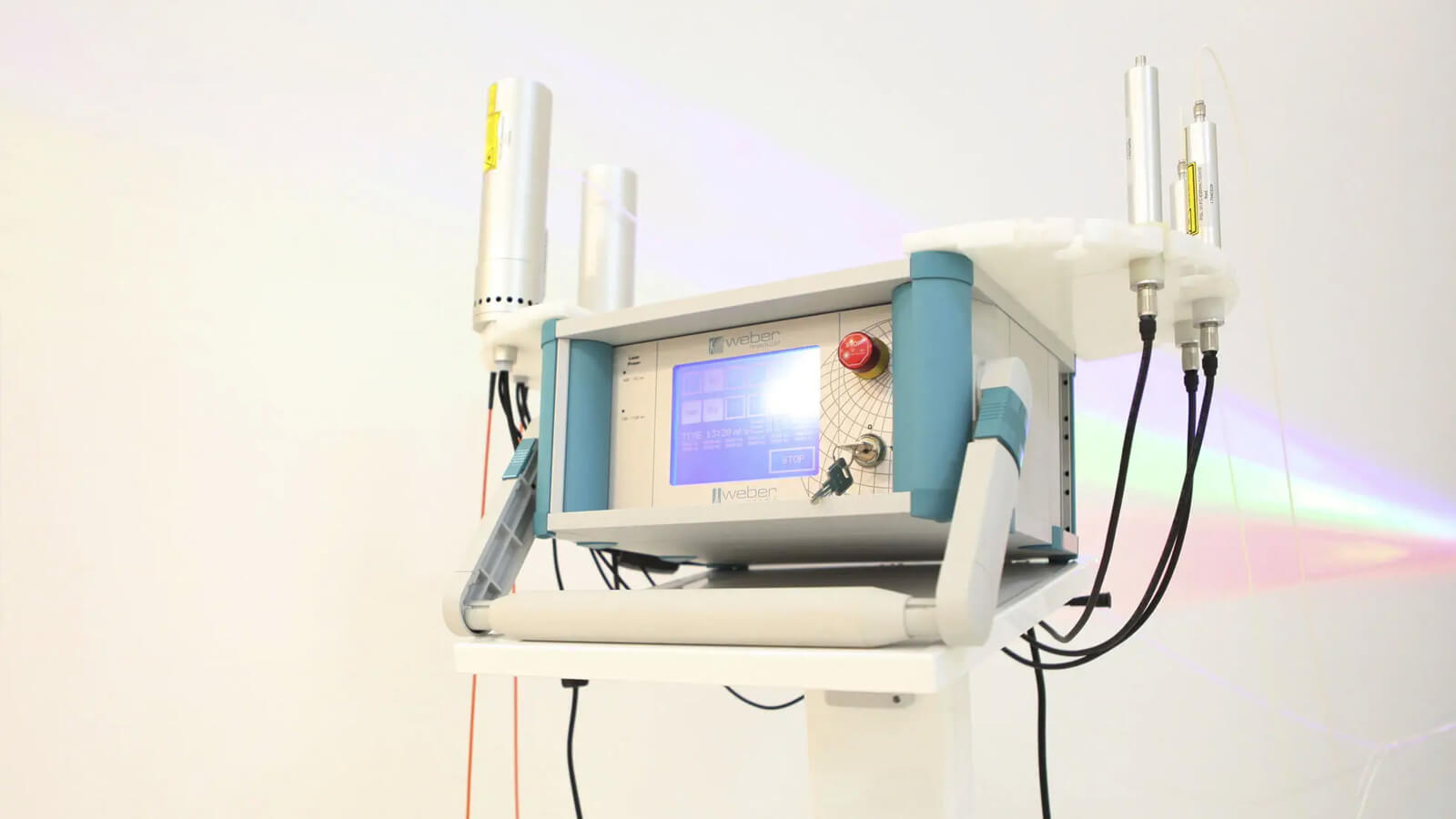
Intravenous Laser Therapy
During intravenous therapy, a catheter is introduced into the vein in the cubital area, allowing blood to be exposed directly to the laser beam. Low-power visible light radiation (1-5mw) absorbed by the blood cells triggers various effects in the body, with the most significant being anti-inflammatory and immune system-stimulating effects, particularly in conditions such as liver and skin disorders, diabetes, and cancer.
The therapy is administered in sessions lasting 20 to 60 minutes, 3-5 times per week, with a total of 10 sessions that combine the effects of different laser wavelengths (red, green, blue, infrared). Currently, this technology is being successfully utilized in clinics in Europe, North America, and Japan.
Recommendations
- Allergies
- Rheumatoid Arthritis
- Lyme Disease
- Chronic Kidney and Liver Diseases
- Heart Conditions
- Bone Calcifications
- Cancer
- Bruises
- Macular Degeneration
- Diabetes
- Discopathies with Sciatica
- Protruded or Herniated Discs
- Dyslipidemia
- Cervical and Lumbar Pain
- Eczema
- Fibromyalgia
- Soft Tissue-Associated Fractures
- Hypertension
- Chronic Fatigue
- Osteoarthritis
- Polyneuropathies
- Rheumatism
- Multiple Sclerosis
- Chronic Pain Syndromes
- Burnout Syndrome
- Tendinitis
- Tinnitus

Laser therapy can alleviate pain, reduce inflammation, and expedite the healing processes in the case of numerous acute and chronic conditions.
Among the health benefits of this therapy are:
- Reducing the need for medications in various pathologies.
- Optimizing metabolic status in diabetics (e.g., reducing HbA1c).
- Improving specific blood marker values in liver pathology.
- Enhancing immune function (activating macrophages, improving T cell activity, stimulating interferon, interleukins, and cytokine production).
- Improving the overall well-being of patients with depression, chronic fatigue, and burnout syndrome by increasing serotonin and monocyte levels.
- Reducing anxiety.
- Improving sensorimotor functions in multiple sclerosis patients.
- Enhancing hypothalamic and pituitary activity.
- Alleviating pain, including in treatment-resistant patients.
- Enhancing athletic performance.
- Treating fibromyalgia and rheumatism by reducing fatigue, depression, increasing muscle oxygenation, and reducing muscle pain through increased endorphin release.
- Treating insomnia by increasing melatonin levels.
- Reducing the need for antihypertensive medication in severe hypertension patients.
- Improving blood rheological properties.
- Reducing the risk of embolism and thrombosis.
- Enhancing microcirculation and reducing ischemic areas.
- Treating coronary diseases and cardiomyopathies.
- Reducing cardiac arrhythmias.
- Preventing restenosis.
- Treating varicose diseases.
- Accelerating skin healing processes.
- Detoxification.
- Reducing body infections and exerting an antitumor effect by generating singlet oxygen and free radicals in photo-stimulated cells, cytotoxic molecules against pathogens and cancer cells.
- Periodontal disease, dental caries, oral infections, and oral candidiasis.
- Stimulating bone repair processes through fibroblastic and osteoblastic proliferation activation.
The laser in different colors can have different effects on the body when applied in intravenous therapy
Each color of the laser has a specific wavelength, which can result in various biological responses. Here are some examples of effects associated with the laser colors used in intravenous therapy:
-
Red - 635 nm
- ATP increase
- Improvment of immunologic activity
- Enhancement of immunoglobulin production
- Reduction of pathologic circulating immune complexes and reduction of CRP in patients with acute and chronic inflammations
- Stimulation of interleukin-1-alpha, interleukin 8, TNF-alpha and Interferon-gamma (wound healing)
- Activation of phagocytic activity of macrophages in combination with structural modifications
- Increase of lymphocyte activity: Rise in number of lymphocytes and positive effects on helper T cells and suppressor T cells
- Positive effects on rheological properties of blood
- Increase of cell activity and microcirculation
- Increase of oxygen amount in the blood
- Stimulation of metabolism
- Calming of nerves and heart rhythm
- Muscle relaxation
- Fat reduction and cholesterol reduction
-
Green - 532 nm
- Improvement of function and cell elasticity of erythrocytes
- Stimulation of sodium-potassium ATPase activity
- Increase of Fibroblast growth and improvement of glucose metabolism
- Improvement of blood viscosity
- Improved circulation and oxygen supply
- Activation of repair processes
-
Blue - 405 and 447 nm
The blue laser is utilized against inflammatory processes because it is proven that it has very strong anti-bacterial and anti-inflammatory effects.
- Reduction of cholesterol , triglycerides and bilirubin
- Improvment of immunologic activity
- Enhancement of NO production (NO= Nitric Oxide) which leads to better microcirculation
- Activation of telomerase (Anti Aging effects)
- Wound healing
- Improvement of oxygen utilization in the tissue
-
UV - 375 nm
UV light irradiation has the following effects that strengthen the immune system and thereby the whole organism:
- Improves the oxygen absorption in tissue
- Prevents the replication of viruses, bacteria and fungi
- Prevents blood platelet aggregation
- Improves blood circulation by dilating blood vessels
- Improves the body’s ability to detoxify and eliminate toxins
- Activates cortisone-like molecules (sterols) in vitamin
- Restores normal size and mobility of lipid elements
-
Yellow - 589 nm
- Mood-enhancing effects especially in combination with hypericin (natural antidepressant) by stimulation of serotonin and vitamin D metabolism
- Therapy of panic attacks and anxiety disorder
- Detoxifying effects
It is important to note that the use of specific laser colors in intravenous therapy can vary depending on the condition being treated and the specific therapeutic protocol. The decision regarding the color and wavelength of the laser should be made by a medical specialist or an experienced laser therapist. These technologies are continually evolving, and scientific research continues to explore various applications and potential benefits of laser therapy in different colors.
Crafting Excellence in Healthcare:
Low-Level Laser Therapies at ImunoMedica Clinic
How can you become a patient of our clinic?
Throughout the whole process, from your initial contact, through treatment and after you leave our clinic, our patient coordinators will guide you through the steps and support you with all their expertise, attention and kindness.
*
We are here to help you
Our patient coordinator will contact you soon
Phone: +40.771.518.946, e-mail: office@imuno-medica.ro








